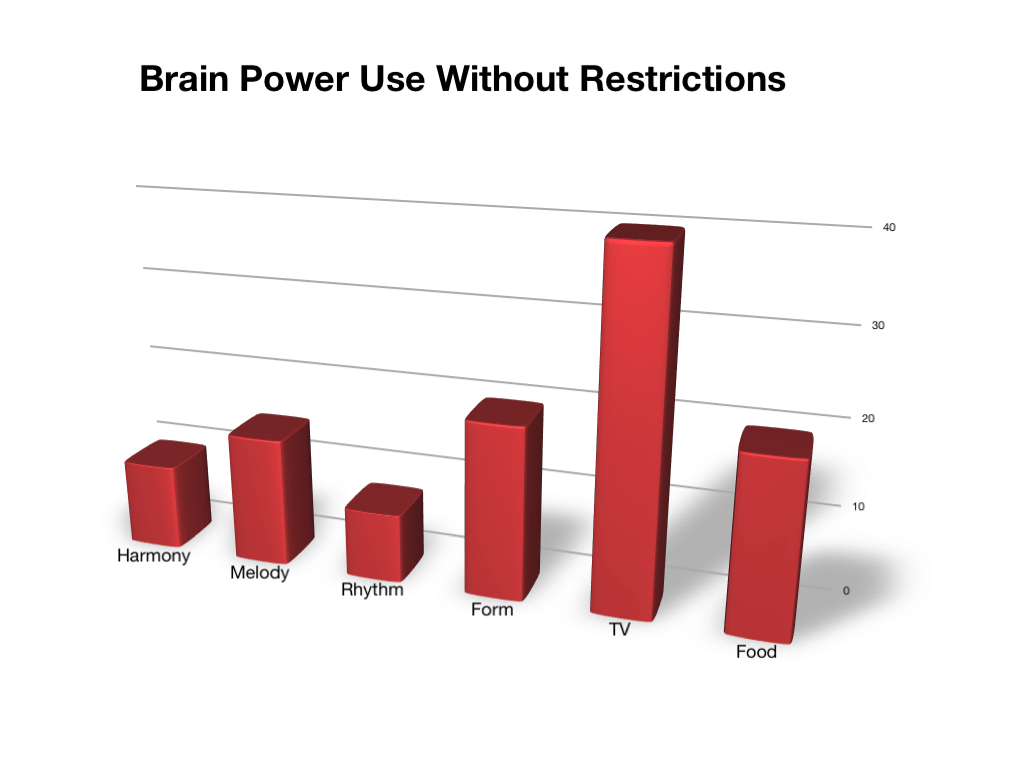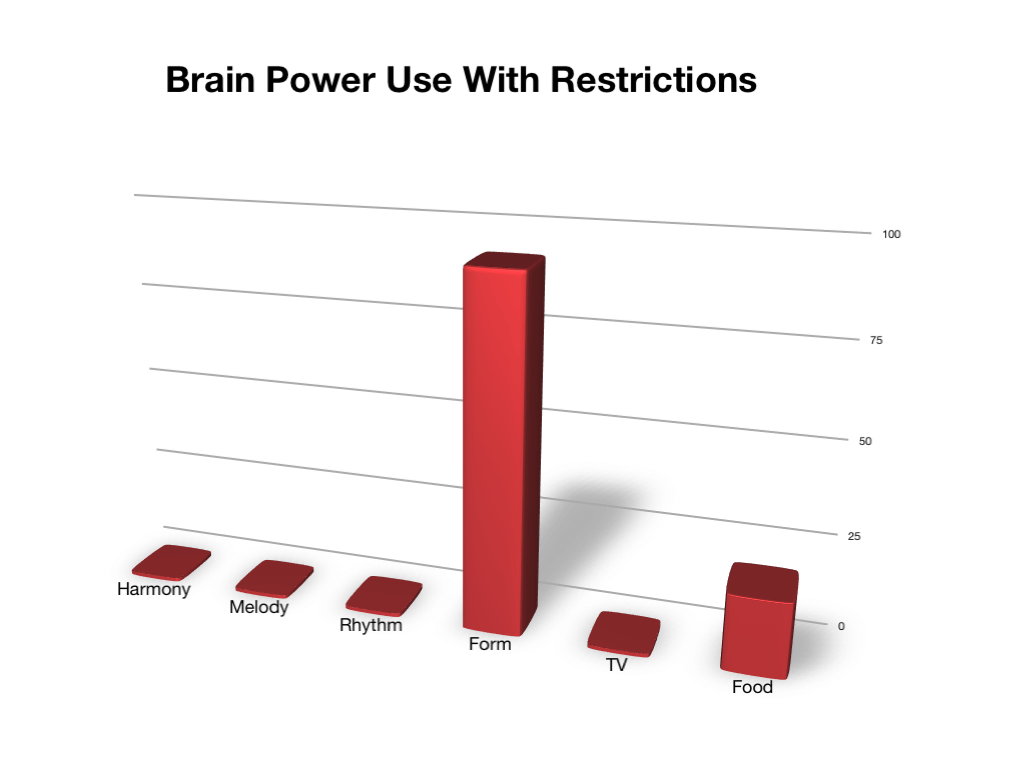What is a Continuation in Music
Musical Phrases – The Big Picture

"Man that was a great two bar continuation phrase, with awesome fragmentation and melodic liquidation!" Super Music Nerd
In the grand scheme, no one is going to listen to your Symphony and say, "Man, that was a great two bar phrase." Well… maybe some music nerds, like me, but most people won't care, in fact, most people will hear it as a whole, or at least as whole movements.
So why care about musical phrases? Because they are the vehicle that we will use to unlock our latent creativity. Understanding their use will allow you to write your music with a new sense of clarity and fluency that may have been lacking before.
Mental Restrictions and Musical Creativity
I have written quite a bit so far on using restrictions in your composing. I believe, as do others in other fields, that restrictions are a great way to increase creativity, not decrease it. The reason is simple. We, as humans, have limited brain power. The more we have to think about, the less we can devote that brain power to certain subjects.
I'll illustrate this below, with very scientific looking data.


Clearly the answer to great composing is turning off the TV, and eating a decent meal before hand.
Different Restrictions at Different Times
So, now we get on to today's main purpose. Last week, we looked at writing a simple phrase. We used this definition:
A short musical statement, that has structural completeness, and is comprised of integrated musical events, which lends itself to being combined with other similar statements.
But this definition doesn't show the whole picture. It doesn't say why we are concerned about writing musical phrases.
Theme Types and Musical Phrases
A small musical phrase on its own, doesn't mean much. It has to be combined with other musical phrases. No one ever said, "I did it! I finally composed Phrase No. 1!" The phrase is just a part of the big picture. The next step in the big picture is the Theme. Let's examine the most important theme types: Sentence, Period, Small Binary and Small Ternary. They all share commonalities, but they also have some striking differences. For an in-depth discussion of this, check out Classical Form: A Theory of Formal Functions for the Instrumental Music of Haydn, Mozart, and Beethoven, by William Caplin. In this post, we'll take a look at the Sentence, and then few posts, we'll follow up with the Period, Small Binary and Small Ternary.
The Sentence
What is a musical sentence? In its most simplest sense, the musical sentence is an 8 measure theme, that consists of two different phrases. Each phrase accomplishes different formal functions. The overall purpose of a sentence is to help establish a tonality and to present the basic material that a composition is made of. The music sentence is a vehicle for presenting your ideas. It accomplishes the "formal functions" of presentation, continuation and cadential.
The archetypal sentence, consists of two, 4 bar phrases. These are the presentation phrase, and continuation phrase. Contained within the continuation phrase, is the cadence.
The Presentation Phrase
This musical phrase normally establishes the tonic, or the home key. It states a basic idea. This basic idea can have any number of motives, but you don't want to overwhelm your listeners with confusion, so normally you will have one or two motives at most. After the basic idea is stated, it is normally repeated. In order for this repetition to establish the home key better, it will have to fall into one of three categories: exact, statement-response, or model-sequence.
Exact Repetition
This is just as it sounds. You have an exact copy of the basic idea.

Model-Sequence
This type of repetition is usually transposition of the melody up or down in diatonic sequence. It is called model sequence because the first statement is considered the model, the second – the sequence.

Statement-Response
This is probably the most common type of repetition in a sentence, especially an opening sentence. The basic idea is stated, and although is a fully contained unit, it has a force that wants to continue. Stating the basic idea in tonic, the best way to move it along and establish the home key even more, is to restate the basic idea indominant. Normally, the melody only changes enough to fit the new harmony, and is not drastically changed in terms of where it sits on the staff or range. This also gives the sense of a response to the first statement. Let's also continue on with the rest of the sentence.

Continuation Phrase
After the presentation phrase, we follow up the music sentence with a continuation phrase. The continuation phrase can have the same types of repetition as the presentation phrase, but it also has some other unique characteristics. These are: Harmonic Acceleration, Fragmentation, Liquidation and a Cadential Idea.
Harmonic Acceleration
This is speeding up the time change of the underlying harmony. In the presentation phrase, the harmonic speed is one chord for two bars. In the continuation it starts as one chord per bar, and then speeds up in bar 7 to two chords per bar.
Fragmentation
This is basically what it sounds like. You break up the basic idea into smaller fragments, usually one of the unique motives. You can use this for the repetition.
Liquidation
If you take a look at bar 7, you'll notice that the melody starts to get very simple, leading into two half-notes. This is called liquidation, and it is "stripping away" the uniqueness of the melody and simplifying it.
Cadential Idea
This is basically ending your theme with a cadence. In this case, I chose to leave it open with a half-cadence. Normally you would not end your first sentence on an authentic cadence, unless you had a half-cadence within the presentation phrase.
Put It All Together, and You Got Yourself a Musical Stew
That pretty much covers the sentence. Listen to the complete sentence one more time, but this time, close your eyes, and see if you can hear the different parts. Its a good test. If you have trouble, check out the review of terms below.
Review:
In this post, we introduced the idea of musical phrases being the basis of the basictheme types:
- Sentence
- Period
- Small Binary
- Small Ternary
We looked at the parts of a musical sentence:
- Presentation Phrase
- Continuation Phrase
Finally we talked about the what goes on in each part of the musical sentence:
- Motives
- Repetition: Exact, Model-Sequence, Statement-Response
- Harmonic Acceleration
- Fragmentation
- Liquidation
- Cadential Idea
Next Week
In the next post, we'll look at the period, and how it differs from a sentence. If you missed the first post on phrases, check out Warning: The Composing Secret Mozart Didn't Want You To Know.
Don't forget to catch up on the entire Symphony of Enlightenment Series.
I'd love to hear your thoughts. Make sure you leave a comment below the post.
Jon
Source: https://www.artofcomposing.com/04-musical-phrases-unleashed
0 Response to "What is a Continuation in Music"
Post a Comment